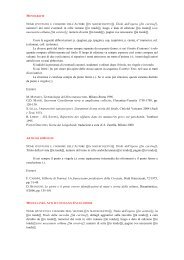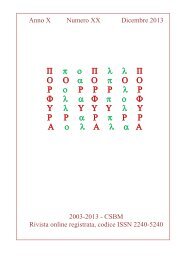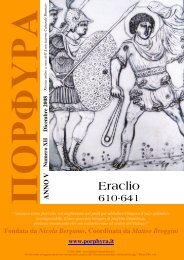ΠΟΡΦΥΡΑ - Porphyra
ΠΟΡΦΥΡΑ - Porphyra
ΠΟΡΦΥΡΑ - Porphyra
You also want an ePaper? Increase the reach of your titles
YUMPU automatically turns print PDFs into web optimized ePapers that Google loves.
A Prôtospatharios, Magistros, and Strategos Autokrator of 11 th cent.<br />
the equipment of Georgios Maniakes and his army according to the Skylitzes Matritensis miniatures<br />
and other artistic sources of the middle Byzantine period.<br />
It seems evident to me that the authors are not using here the<br />
word µανικια as simple word for “sleeve” but to indicate an<br />
element of protection from the shoulder down to the elbows and<br />
then from the elbows to the hands 90 .<br />
The fastening system can be seen by a scanner analysis<br />
of this source: it seems to be a system formed by two rows of<br />
metallic lamellae ; a leather thong held each lower longer<br />
lamella strongly tied to the higher ; the whole structure formed a<br />
single compact lamellar bracelet put on a soft base, probably<br />
made of leather or κουκουλιον. The koukoulion was a kind of<br />
silk of low quality but strong and used for padding parts of<br />
military dress as well, as being used for instance for the<br />
καβαδια and kremasmata edges of the κλιβανιον. 91 The<br />
bracelet was then possibly fastened around the arm by means of<br />
a metallic boned clasp (fig.7 n. 8), like a true bracelet, probably<br />
in the way shown by clasps of a pair of 9 th century επικαρπια<br />
of a senior officer found in Thessaloniki. 92 An other way to<br />
fasten similar µανικια to the arm was with a simple buckle, as<br />
shown in a fresco of the Church Karanlik in Goreme,<br />
Kappadokia. 93<br />
The shield of Maniakes (σκουταριον - fig.7 n.5), is<br />
based on the miniature of Skylitzès showing him in his last<br />
battle (fig.3). It is the so-called kite-shield or “three cornered<br />
shield”, of about 105,3 cm. c. length described as used by the<br />
cavalry in the Sylloge Tacticorum ( 39,1) and of about 93,6-117<br />
cm. described, always for the cavalry, by Praecepta Militaria<br />
(IV, 36-37) 94 . This shield was circa 70 cm. wide in the largest<br />
point 95 . The structure was normally wood-framed covered by<br />
leather, and in our reconstruction, by blue-dyed donkey or oxen<br />
hide 96 , with a red- leather edge stitched all-around and riveted<br />
padded cloth, felt, wadding, just as mentioned in the passage of Praecepta Militaria mentioned above, or in boiled<br />
leather: S. also Leo, Taktika,V,3; Syll.Tact.,39,2. About it s. Kolias, Waffen, pp.65-69 ; Mc Geer, Showing..., p. 62 ;<br />
Haldon, Expeditions, p. 289.<br />
90<br />
A interesting confirmation comes from the fresco of the Church of the Serpent, in Goreme, above mentioned. Here<br />
the cavalryman wears, from the point on the shoulders where ends the lamellar armour : 1) until the elbows - after a<br />
short space of padded cloth - a metallic µανικιον (the colour used in the fresco is the same for the iron of the<br />
κλιβανιον) ; 2) from the elbows to the hands is padded cloth protection, followed by metallic plates forming a short<br />
cheiropsellon protecting the forearm. It seems to me that we have all the elements described in Praecepta Militaria,<br />
even ζαβαι covering both µανικια and µανικελλια formed by metallic and not metallic materials. The fresco dates of<br />
the 11 th century. See a colour photo in Güven F., Cappadoce, Goreme, Eski Nevsehir, p. 23.<br />
91<br />
Praecepta Militaria, I,3; III, 4 ; Nikephoros Ouranos 56,3 ; 60, 4 s. Mc Geer, Showing.., p. 12-13 ; 34-35 ; 61-62 ;<br />
88-89 ; 113-115 ; Kolias, Waffen, 56-57 and notes 149-150.<br />
92<br />
Hetherington-Forman, Byzantium, p. 90; Wessel K., Die byzantinischen Emailkunst vom 5. bis 13.Jh,<br />
Recklimghausen 1967 pl.14; these magnificent specimens are represented as dressed on the wrists of an Imperial<br />
Guardsmen in the folio 215v of the Gregorius Nazianzenus Cod. Gr. 510 de la Bibliothèque Nationale de Paris, 9 th<br />
century, cfr. Der Nersessian, L’illustration, I pl. XXXIX p. 23. I worked on a film of the miniature to note the detail.<br />
93<br />
See Gűven, Cappadoce, p. 32 ; Nicolle, Arms and Armours, fig. 530a.<br />
94<br />
See McGeer cit. p. 40-41 and p. 72; Kolias, Waffen, p. 109; Heath, Byzantine Armies, cit. plates C 1, H 2,3 and pp.<br />
35, 40.<br />
95<br />
See Heath J., Armies of the Dark Ages, 600-1066, Worthing, 1980, p. 68 fig. 13.<br />
96 th<br />
The use of donkey hide for military shield is attested, for the 11 century, by a letter of Maximos Planudes, who<br />
complains about the parchment sent to him to writing, made of donkey hide. He says that it should be better used by the<br />
20

















